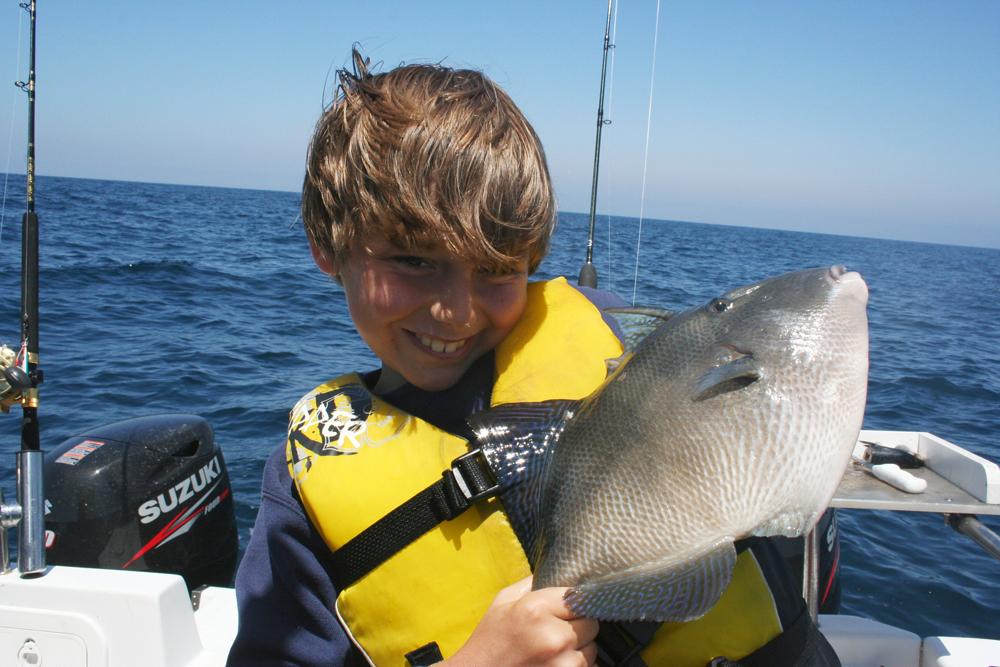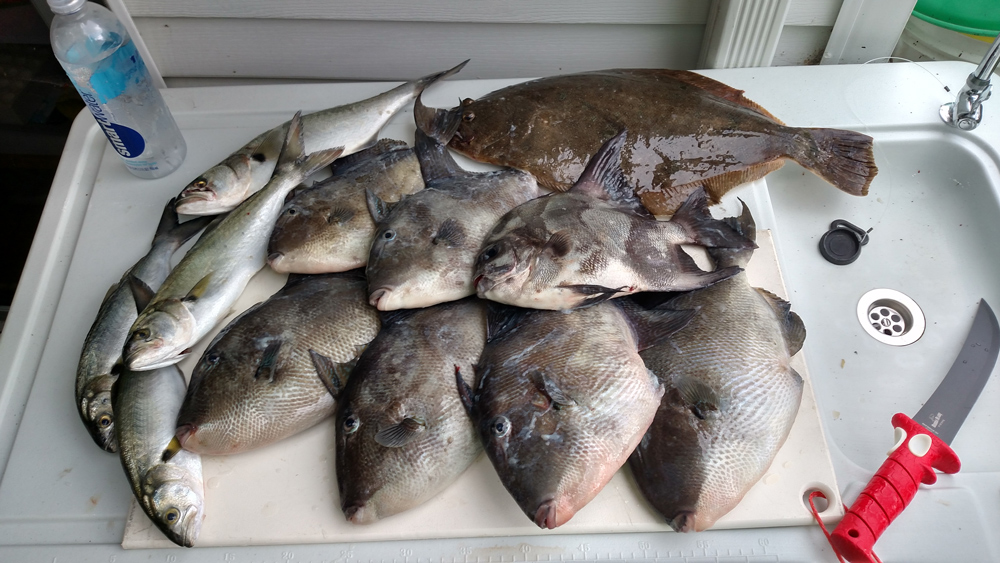Summer fishing at the CBBT (Chesapeake Bay Bridge Tunnel) can produce fish like red drum, cobia, and flounder, but there are also some lesser-known species that provide lots of action such as spadefish and triggerfish. Some folks regularly fish for spadefish at the CBBT, but I don’t know of anyone who specifically targets triggers there. They have always been around, and occasionally I have caught one while fishing for something else. But until last summer, I never spent any real time targeting these two species together. What started as a “Plan B” option one day led to several productive trips followed by tasty dinners.

I was looking for red drum in one of my usual haunts one day last summer. The last few times I had been out there I had noticed fish on the fish-finder hovering about eight feet down. This often indicates spades. So this time I came prepared with some chowder clams. I slid the anchor over the side, baited a couple of lines with pieces of clam, and put them in rod holders. I cast a jig while I waited – but I didn’t have to wait long before one of the rod tips twitched a couple of times and bent towards the water. Sure enough it was a spadefish. Then the other rod went over, and I had another. Spades are schooling fish, and once you get their attention they will hang around and keep hitting the baits.
After boating a couple more spades, one of the rods bent over and began taking drag. I thought it was a bigger spade, but when I got it to the boat it was a triggerfish. If you’ve never seen one of these guys, they are peculiar to say the least. They have a small mouth and skin like leather. They get their name from a spike fin in front of their dorsal that can stick you like the barb on a catfish. They have a “trigger” behind the spike that allows it to fold back down along their back.
These two species have a few things in common. Both are wide-bodied fish that are capable of surprisingly strong fights (you freshwater anglers – think of bluegills on steroids). Both like to hover directly over bottom structure. And both are welcomed dinner guests at my house any time.
Once I knew the triggers were around, I switched the baits on one of my rods to target them. I had been catching bluefish on the jig which meant I had several sliced-up Gulp tails. In place of the clam I put small pieces of Gulp on the hooks and dropped the rig just a few feet off the bottom. Sure enough, I caught several triggers on this rig. Triggerfish LOVE pieces of Gulp tails. In fact, if you’re ever jigging with these lures and keep feeling something nibbling but never seem to hook them, check the Gulp tail for small circular chunks bitten out of it. This is a sign there are triggers around.
Where and How to Catch Spadefish and Triggerfish
For the next several weeks, spades and triggers became my Plan A. Any of the four islands of the CBBT will hold both of these species. Anchor up in about 15 to 20 feet of water, about 30 to 40 feet from the rocks. Areas with chunky bottoms seem to work the best. Not all locations hold fish all the time. If you’re out speculating, look for the spades on your bottom machine in large schools from five to 10 feet down then anchor up and work that area for a while.
Just about any bottom structure will attract these fish. I’ve caught both on inshore wrecks and reefs out to the Chesapeake Light Tower and on similar structure in North Carolina. In fact, the Chesapeake Light Tower Reef is often a hot spot for spades. You will not always find both species on the same structure, but one or the other will typically be found hovering around any bridge, reef, or wreck.

I’ve already mentioned the bait: clams and pieces of gulp. The clams are chowders, which aren’t always easy to find in the summer months. Frozen clams don’t work as well, as the flesh gets too soft and doesn’t stay on the hook. Break open the clam and scoop out the meat. You’ll notice a “foot” that’s tougher than the rest of the flesh. Slice the clam into three or four pieces, making sure each piece has some of this tough part, and hook the bait through this foot.
Since finding fresh clams can be hit or miss, I started salting the clams when I could find them. I’d buy a few dozen clams, clean them, and cut them into bait size. Then I would cover them in kosher salt and put them in the refrigerator. After a couple of days, I divided them and put them into zipper plastic bags. These baits last for a long time in the fridge or freezer without going bad. They hold up on the hook, and the fish love them.
I tie rigs with three small hooks. The hooks are 2X strong, from size two to size 2/0 circle or octopus style. Space the hooks about a foot apart on dropper lines made with 25-pound fluorocarbon leader material, with another foot down to a loop for attaching a one-ounce sinker. Conventional reels with 20-pound braid are good for this type of fishing, but spinning tackle will do in a pinch. When the spades get up to dinner plate size, beefier tackle is needed. A 10-pound spadefish will give you a run for your money (as will a larger trigger).
As mentioned, I apply the RH (rod holder) factor for these fish. By this I mean I stick the rod in the rod holder and leave it there, because when you hold the rod in your hand you’ll be tempted to try to set the hook too soon. These fish have small mouths, and they like to nibble on their dinner. Let them nibble until the rod tip points toward the water. At this point there’s no need to set the hook, the fish has done it for you.
Cooking Triggerfish and Spadefish
Both triggers and spades make excellent table fare. Spades may be filleted like any other fish. Triggers require some finesse. A quick trip around YouTube will reveal several methods for cleaning triggers. The method I use begins by plunging a filet knife straight through the side of the fish just behind the pectoral fin. Cut all the way through the fish, slicing down to the anal vent. Then slice just under the skin beginning from the hole behind the pectoral fin, up to the top of the fish. Continue slicing down the top of the fish to the tail. Then work the blade from the tail to the vent, and finish filleting the fish. There will be a line of small pin bones along the backbone that need to be removed.
These two fish are great battered and fried. They are also fine on the grill or in the oven. Each has its own distinct flavor, but they’re delicious eaten together in the same meal. Try them fried in a flour and cornmeal mix, with some cornbread and corn on the cobb. Hey, it’s summer – corn is essential!
Currently, you may keep four spades of any size in Virginia (check the current Virginia regulations here). There are no restrictions on triggers in our state. I throw back the smallest fish of either species, only keeping a few for the table.
- By Chuck Harrison
Sign up here to get the weekly FishTalk Chesapeake Bay and Mid-Atlantic fishing reports in your email inbox, every Friday by noon.